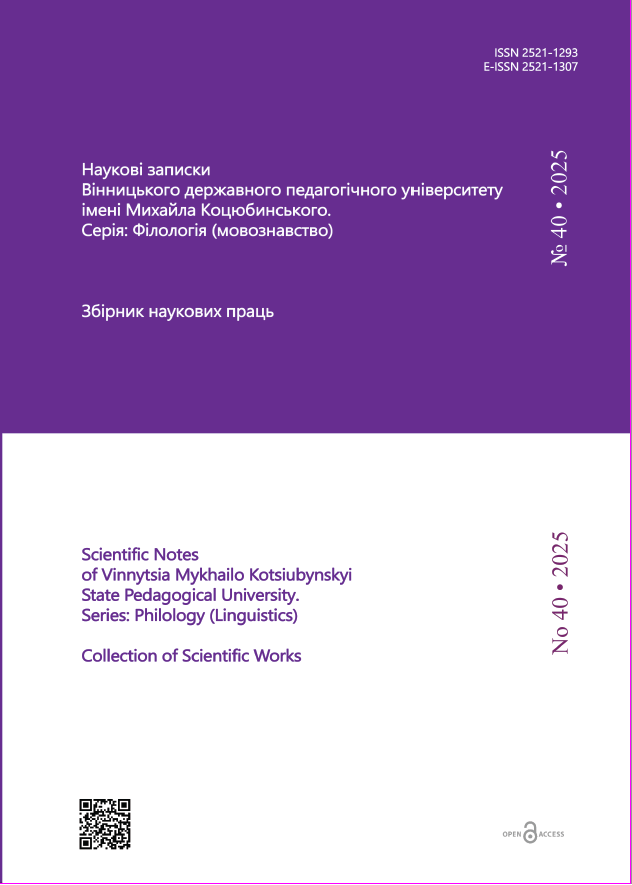Economic terminology in book «My Life and Work» by Henry Ford
https://doi.org/10.31652/2521-1307-2025-40-05Published 2025-07-07
Keywords
- economic terminology, thematic groups, morphological analysis, structural features, translation techniques

This work is licensed under a Creative Commons Attribution 4.0 International License.
How to Cite
Abstract
The study of specialized vocabulary within works of fiction offers significant benefits to linguistics by enabling the assessment of scientific and technological language’s integration into artistic expression. Furthermore, translation of economic terminology used in different functional styles is a topic of continuing relevance in modern linguistic studies, since this process demands careful consideration of its lexical and grammatical properties, structure and etymology. The purpose of the paper is to study semantic, morphological and structural features of economic terminology used by H. Ford in his book My Life and Work, and to analyze the methods of its translation into Ukrainian used by U. Dzhaman. The methods used in the study include analysis, synthesis, induction, deduction, classification, continuous sampling of language material and linguistic analysis, quantitative analysis, statistical, graphical, as well as methods of logical, semantic, system-structural analysis, comparative and dialectical approaches. Results. By semantic criteria, the selected economic terms were distributed in 5 thematic groups: Production and Work Organization, Finance and Investment, Marketing and Sales, Economics, and Agriculture and Production. Economic terminology is predominantly composed of single-word terms, representing nearly half (49.5%) of the total; these are mostly derivatives (51.85%), followed by simple terms (38.9%), with compound terms being the least common (9.25%). Two-component terminological collocations make up 34.9%. Three-component terminological collocations account for 12.8%, while four-component terminological collocations are the smallest category, comprising only 2.8% of the economic terms. The structural analysis evidences that among the selected English economic terminological collocations prevailing are two-component terms which are presented by the following structural models: Adj + N, N + N, Adv + Adj. Among the three-component terms, the following structural models were identified: N + Prep + N, Adj + N + N, V + Adj + N, Adj + PII + N, N + Adj + N. Four-component terms, according to the analysis of selected terms, are built on the following structural models: Adj + N + Prep + N, V + N + Prep + N, Adv + Adj + Prep + N, N + N + Prep + N. Analysis of the translated terms reveals that calquing is the most frequently used technique, making up 28% of the total number of the lexical units under analysis, with synonymous substitution following it (16%). Contextual substitution represents 14% of the translation techniques used, while descriptive translation makes up a slightly smaller portion at 12%. Permutation and transposition each account for 9% of the total. The combined method constitutes 5%, transcoding makes up 4%, and compression has the lowest occurrence constituting 3%. The originality of this paper lies in a detailed semantic, morphological and structural analysis of economic terminology used in H. Ford’s book My Life and Work, as well as an analysis of the employed translation techniques. Conclusion. The study confirms that the book employs a multitude of economic terms that have different semantic, morphological and structural features. A wide range of translation methods was used, calquing being dominant. Further research into the semantic, morphological and structural features of economic terms used in other literary texts, as well as quantitative analysis of translation methods used in translating economic lexis into Ukrainian is required.
Downloads
References
- Ford, H. (1922). My Life and Work. Garden City. New York : Doubleday, Page & Company, 284 p. (in English).
- Ford, H. (2016). My Life and Work. Translated from English by Uliana Dzhaman. Kyiv : Nash Format, 352 p. (in Ukrainian).
- Homon, A. M., Zaveriushchenko, M. P., Pysarska, N. V. (2022). Spetsyfika vzhyvannia naukovykh terminiv u suchasnii khudozhnii prozi [Specificity of the use of scientific terms in modern artistic prose]. Scientific Bulletin of the International Humanitarian University. Series: Philology: collection of scientific articles, pp. 34-37. https://doi.org/10.32841/2409-1154.2022.54.8 (in Ukrainian). DOI: https://doi.org/10.32841/2409-1154.2022.54.8
- Horda, V. V., Pushyk, N. V. (2021). Funktsionuvannia yurydychnykh terminiv u khudozhnomu dyskursi (na prykladi opovidan Jeffrey Archer “The Chinese Statue”, “The Coup”) [Functioning of legal terms in artistic discourse (on the example of stories by Jeffrey Archer “The Chinese Statue” and “The Coup”)]. Transcarpathian philological studies, vol. 1, issue 19, pp. 118-124. https://doi.org/10.32782/tps2663-4880/2021.19.1.22 (in Ukrainian). DOI: https://doi.org/10.32782/tps2663-4880/2021.19.1.22
- Horodylovska, H. P. (2003). Pravnycha terminolohichna leksyka v istorychnykh tvorakh Romana Ivanychuka [Legal Terminology in the Historical Works of Roman Ivanychuk]. Scientific Notes of the National University of Kyiv-Mohyla Academy: Philological Sciences, vol. 22, part 1, pp. 43–47. (in Ukrainian).
- Ishchuk, N., Hrachova, I. (2022). English Economic Terminological Collocations and Their Translation into Ukrainain. Linguistic Studies: collection of scientific articles, issue 44, pp. 100–112. (in English).
- Naumenko, L. P., Hordieieva, A. Y. (2011). Praktychnyi kurs perekladu z anhliiskoi movy na ukrainsku [Practical Course of Translation from English into Ukrainian]. Vinnytsia : Nova Knyha, 136 p. (in Ukrainian).





